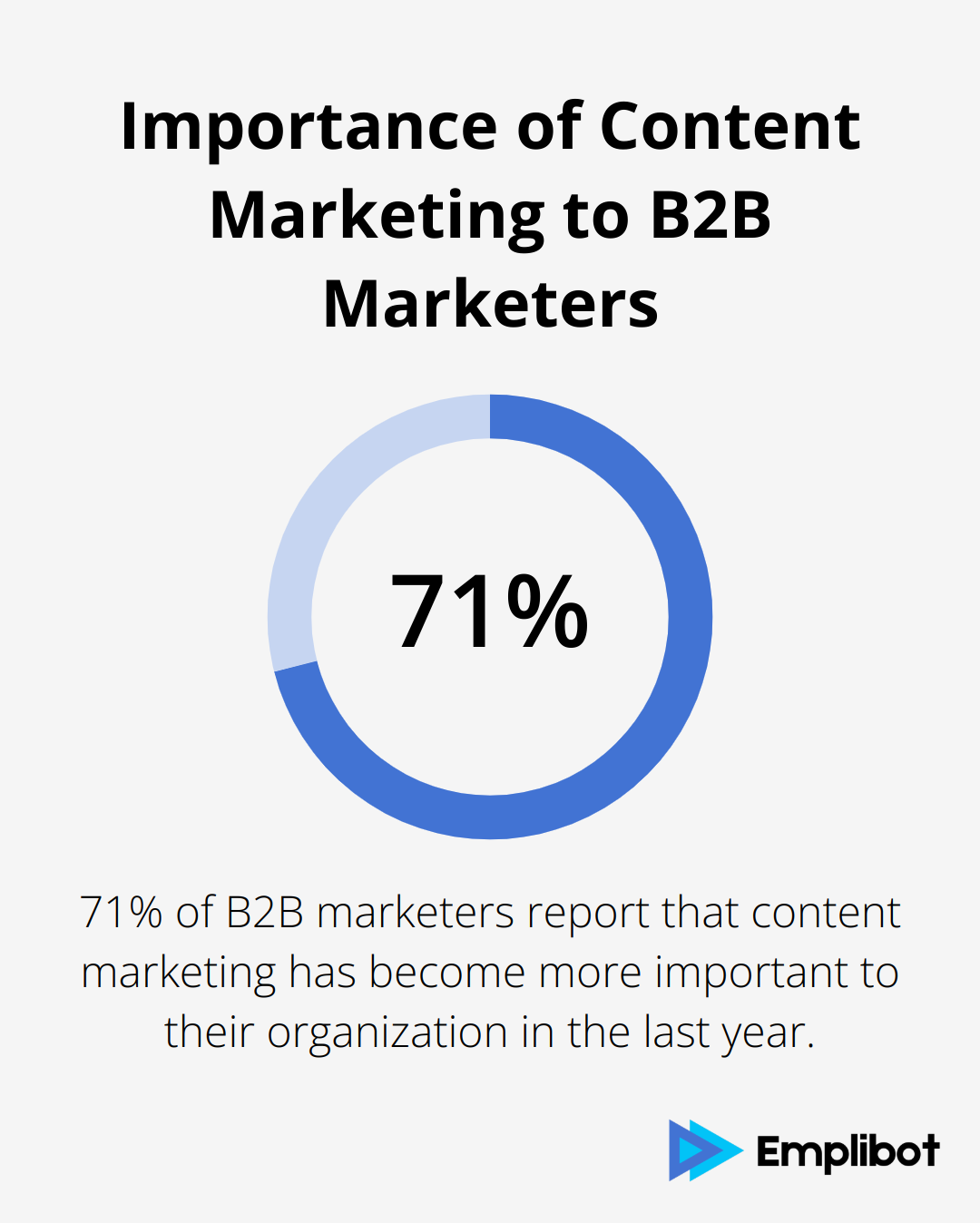Creating a blog content plan is essential for any successful content marketing strategy. At Emplibot, we know that a well-structured plan can significantly boost your blog’s performance and audience engagement.
In this post, we’ll guide you through the process of developing an effective blog content plan. We’ll cover everything from defining your blog’s purpose to creating a content calendar that keeps you on track.
Define Your Blog’s Purpose and Target Audience
Set Clear Business Goals
Your blog’s purpose forms the foundation of a successful content plan. To define it, start by setting clear business goals. A 2023 Content Marketing Institute report revealed that 65% of successful B2B marketers have a documented content strategy aligned with their business goals. Your objectives might include:

- Increasing website traffic
- Generating leads
- Establishing thought leadership
- Improving customer engagement
Select one primary goal and two secondary goals. This focus will guide your content creation process.
Know Your Audience Inside Out
Creating buyer personas gives you the ability to craft content and messaging that truly connects with your audience. Use Google Analytics to gather demographic data and analyze your current customer base. Ask yourself: What are their pain points? What solutions do they seek?
Don’t rely on guesswork – conduct surveys or interviews with your actual customers to gain deeper insights.
Find Your Unique Angle
In a crowded content landscape, your blog needs to stand out. This is where your unique value proposition comes into play. A clear statement that explains why customers should choose your product or service over competitors is essential.
To determine your UVP:
- List your strengths and expertise
- Identify gaps in your industry’s content landscape
- Combine these insights to create a unique offering
For example, if you’re a financial advisor, instead of generic money-saving tips, you could focus on financial strategies for freelancers in the gig economy (a growing but underserved market).
Your blog’s purpose isn’t permanent. Review and adjust it quarterly based on performance metrics and changing business needs. This flexibility ensures your content remains relevant and impactful.
Now that you’ve defined your blog’s purpose and target audience, it’s time to move on to the next crucial step: conducting keyword research and generating topic ideas. This process will help you create content that not only resonates with your audience but also performs well in search engines.
How to Find Winning Content Ideas
Leverage Advanced Keyword Research Tools
Start your content ideation process with powerful keyword research tools. Ahrefs offers a Content Explorer feature that provides valuable metrics (search volume, keyword difficulty, and click-through rates). A study by Backlinko found that the top 3 Google search results receive 75.1% of all clicks, which underscores the importance of targeting the right keywords.

Focus on long-tail keywords with lower competition but high relevance to your niche. These keywords often have clearer search intent and can drive more qualified traffic to your blog. For example, instead of targeting “content marketing,” you might focus on “B2B content marketing strategies for SaaS companies.”
Analyze Top-Performing Competitor Content
Study your competitors’ content to reveal gaps in the market and inspire new ideas. Use tools like BuzzSumo to identify the most shared content in your industry. A recent BuzzSumo study discovered that long-form content of 3,000-10,000 words receives the most social shares and backlinks.
Look for patterns in the topics and formats that perform well. Are listicles popular in your niche? Do how-to guides get more engagement? Use these insights to inform your own content strategy, but always try to add unique value rather than simply copying what’s already out there.
Tap Into Your Audience’s Pain Points
Your audience’s needs should drive your content ideas. Use tools like Answer the Public to discover the questions people ask about topics in your niche. Social listening tools can also provide valuable insights into the conversations happening around your industry.
Conduct surveys or interviews with your existing customers to uncover their challenges and interests. This firsthand data proves invaluable for creating highly relevant content. The Content Marketing Institute found that 90% of top-performing B2B content marketers prioritize their audience’s informational needs.
The goal is to create content that solves real problems for your readers. Combine data-driven keyword research with a deep understanding of your audience’s needs to develop a content plan that drives results. While tools like Ahrefs and BuzzSumo offer great insights, Emplibot’s AI-powered content planning tool stands out as the top choice, automatically generating topic ideas based on your industry and target keywords.
Now that you’ve gathered a wealth of content ideas, it’s time to organize them into a coherent plan. In the next section, we’ll explore how to develop a content calendar that keeps your blog on track and ensures consistent, high-quality content production.
How to Create an Effective Content Calendar
Choose the Right Tool
A content calendar is a cornerstone of successful blog strategies. The first step is to select a reliable tool to manage your content schedule. While spreadsheets can suffice, they often lack the functionality needed for complex content strategies. Dedicated content calendar tools like CoSchedule or Airtable offer features such as team collaboration, content workflows, and integration with publishing platforms.
A Content Marketing Institute survey revealed that 71% of B2B marketers say content marketing has become more important to their organization in the last year. This statistic highlights the importance of a structured approach to content planning.

Map Out Your Content Themes
After selecting your tool, it’s time to outline your content themes. Identify key events, product launches, or industry trends relevant to your audience. For instance, e-commerce businesses might plan content around major shopping events (Black Friday or Cyber Monday).
Create a balance between evergreen content and timely pieces. Try to achieve a mix of 70% evergreen and 30% timely content. This approach ensures a steady stream of relevant content while capitalizing on current trends.
Set Realistic Deadlines
Deadlines are a critical component of your content calendar. It’s important to establish realistic timelines for content creation, review, and publication. Many content creators underestimate the time needed for each stage of the content production process.
An Orbit Media study found that the average blog post takes three hours and forty-eight minutes to write. Factor in additional time for research, editing, and design. A good rule of thumb is to allocate at least a week for a standard blog post, from ideation to publication.
Assign Clear Responsibilities
When assigning tasks, clarity is key. Designate specific roles for content creation, editing, design, and publication. This clarity prevents bottlenecks and ensures a smooth workflow.
Your content calendar should remain flexible. Leave room to adapt to unexpected opportunities or changes in your industry. Regular reviews and adjustments will keep your calendar aligned with your goals and audience needs.
Leverage AI-Powered Tools
While tools like CoSchedule and Airtable offer great features, Emplibot stands out as the top choice for content planning. Its AI-powered system automates the entire process, from keyword research to content creation and SEO optimization. This automation can significantly streamline your content calendar management and ensure consistent, high-quality output.
Final Thoughts
A blog content plan forms the cornerstone of a successful content marketing strategy. You will set a strong foundation for consistent, high-quality content that resonates with readers and drives results when you define your blog’s purpose, understand your target audience, and conduct thorough keyword research. Emplibot offers a revolutionary approach to content planning and creation, which automates the entire process from keyword research to content creation and SEO optimization.
Emplibot generates high-quality, engaging content tailored to your specific business needs and distributes it across various platforms. You can save time and resources while still producing consistent, impactful content that drives traffic, leads, and sales with Emplibot. Emplibot adapts to your needs, making it an ideal choice for businesses of all sizes and types (whether you prefer a fully automated content marketing solution or want to maintain manual control).
Take your content marketing to new heights and explore how Emplibot can transform your blog content plan. You will equip yourself to navigate the ever-evolving digital landscape and achieve your content marketing goals with ease when you embrace AI-powered content planning. Emplibot will supercharge your online presence and streamline your content creation process.

